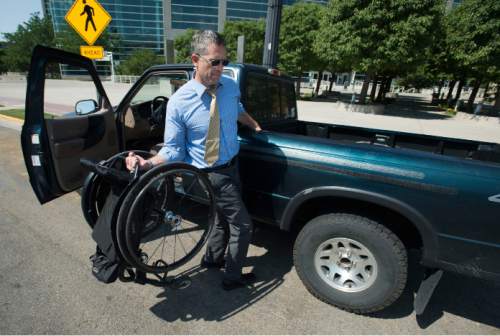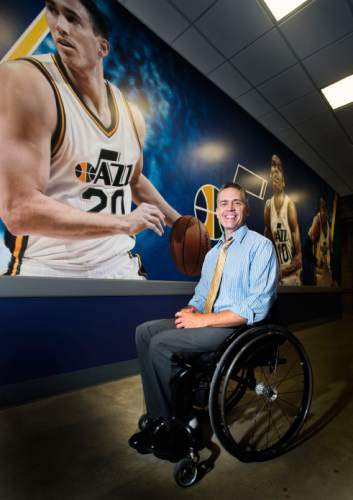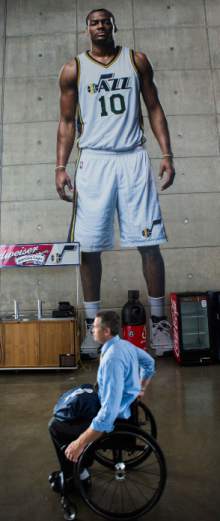This is an archived article that was published on sltrib.com in 2016, and information in the article may be outdated. It is provided only for personal research purposes and may not be reprinted.
Jeff Griffin remembers the heat of the day — and the hurt, when he hit the ground from 40 feet up. The fall shattered bones in his back and altered his life. It shattered his dream, too, which centered on playing receiver for BYU's football team, shifting it to something much more basic: walking. He had no way of knowing at that time he would go on to become a world-class athlete, one of the best wheelchair basketball players on the planet, an eight-time All-Star and four-time MVP for the Wheelin' Jazz.
In the moment, all he could feel was sweat on his face and pain everywhere else — except for his legs. Those he felt not at all. The first words out of his mouth, spoken to a buddy, were: "I think I'm paralyzed."
He was right.
The buzzard-hot August day in 1995 began like most summer days for Griffin. He picked up a friend and headed off from his home in Logan to paint a barn, this one in Preston, Idaho, for the commercial painting business he had started as a means of earning extra cash while attending and playing football for Ricks College. He had bills to pay and he wanted to buy a bullet bike to, he says, "impress the girls."
When Griffin arrived at the barn, he decided to paint the upper far reaches first, building a scaffold and placing a ladder atop it. Everything went according to plan until he felt the ladder move. Seconds later, it was gone, leaving Griffin grabbing for whatever he could to break a fall that would not be broken.
"I grabbed a ledge, but then my fingers popped off," he says. "There was nothing I could do. I hit the ground straight-legged."
The pain jolted him as much as the impact.
"It was worse than anything I'd ever experienced," he says. "It coursed through my body. It was excruciating."
Griffin tried to roll over, but his body wouldn't move. He reached his hand down to touch his leg and it was as though he were touching the dirt on the ground. On a subsequent three-hour ambulance ride from Preston to Ogden — road construction detoured and delayed and doubled the time of the route — fears ran wild through Griffin's mind: "I started thinking my dreams of playing football, of riding a motorcycle, again were shot. I kept thinking, 'What now? What now?' The pain was bad. I just wanted to pass out. I tried to hold my breath. Then I asked the [paramedic] to punch me in the head to knock me out."
The real knockout came later at the hospital, when the doctor informed Griffin that what he had suspected was true. His L-1 vertebrae, located at his waist, had exploded on impact. Then these words, at least by Griffin's recollection, came out of the doctor's mouth: "You're paralyzed from the waist down. You'll never walk again."
There was silence in the room. There was nothing to say.
An eight-hour surgery that included placing a rod with four screws in his back followed.
In the hours, days, weeks thereafter, Griffin rode all the wild emotional undulations. He was angry at his fate, mad at himself for not properly securing the ladder and scaffolding. He was sad. He was uncertain. He was scared. He was depressed. He shook his fist at heaven and earth.
"I had a pity party," he says.
Well-intentioned family members told Griffin that he would walk again, and so, in place of running fly and crossing routes for the Cougars, that became his new dream, putting one foot in front of the other.
"Then, reality hit," he says.
In the 21 years since the fall, Griffin has not walked, not without the help of a walker or something to hang onto while dragging his feet behind him. He still holds onto hope. Outside his home, he rides in a wheelchair, but that wheelchair has become the means by which he has accomplished rarefied athletic achievements.
Somewhere after that initial party of pity, during two-plus months of rehab, Griffin determined to change his view of his new challenge: "Instead of thinking about what I can't do, I started looking at what I can do."
He could dress himself. He could tie his own shoes. He could get in and out of a bathtub on his own. "It took me 30 minutes to put my pants on," he says. "It was hard, figuring out how I could live out of a wheelchair. But I had to start living life again."
Griffin went to Utah State, studying political science and Spanish. Before the accident, he served an LDS mission in Spain. His friends encouraged him to go to a school dance, where he initially hid away, but eventually rolled out on the floor, waving his arms around to the thump of the music.
"I felt dumb, stupid," he says.
The women at the dance did not think he looked dumb, stupid. They lined up to dance with him. One of those women, named Emily, who sat on Griffin's lap during a slow dance — "Yeah," he says, "my first lap dance" — married her man a year later. Since then, the couple has had four children.
Griffin began playing sports, again. He learned to play tennis, golf and basketball. When swinging a golf club, he leans against a crutch as he passes through one-handed, and says he generally shoots in the high-40s for nine holes. Like every other golfer, he's probably lying a bit.
Basketball, though, is his best sport. Not only did Griffin play for Team USA at the 2004 Athens Paralympic Games, he is a star in a league called the NWBA — the National Wheelchair Basketball Association. His Wheelin' Jazz team regularly practices in Salt Lake City and competes against teams near and far. All told, there are some 200 wheelchair teams around the country, with 2.000-plus participants. Frank Layden once described Griffin as the wheelchair game's version of Karl Malone.
"I would compare myself to Dirk Nowitzki," Griffin says. "I sit tall. If you put a big player on me, I go around him. If you put a small player on me, I shoot over him."
All basketball wheelchairs sit 21 inches off the ground, and from there, it's up to the athletes to use their size, strength, speed and touch to do their business.
Griffin, now 43, has traveled the world balling away, from Greece to Sri Lanka to the Dominican Republic to Nepal to Japan to Canada to the Netherlands. He's most proud of helping establish junior programs for wheelchair athletes, an endeavor, he says, that gives youngsters a vision and hope for what they can accomplish in their lives.
Emily says her husband, who is now an LDS Seminary teacher, as well as player/coach of the Wheelin' Jazz, fires off an uninterrupted stream of positivity to those around him:
"He's the most positive person I've ever met. He exudes happiness. That's what I fell in love with. We've been married for 19 years now. He's been a blessing to me. He's my rock. … Everything he does just takes a little more effort. But he makes everything seem so fine. He makes things fun. Instead of making people feel sorry for him, he wants to show them what he can do."
There's no sugarcoating what's real. There are difficulties.
"Sometimes I see him fall," Emily says. "Just yesterday, the front wheels in his wheelchair got stuck in a crack in the sidewalk, and threw him out onto his knees. But he makes everything, all the day-to-day things, seem OK."
And they are OK.
"I've pushed myself," he says. "I've learned, you're only a thought away from changing your life. It begins there. I try to help people change their attitudes about life. I try to give hope that everybody can live a life of 'I can,' not 'I can't.' If I can do that, anyone can. I'm just a regular guy. I'm nothing special. I've never been extraordinary."
Au contraire on that last part, Jeff Griffin. Au contraire.
GORDON MONSON hosts "The Big Show" with Spence Checketts weekdays from 3-7 p.m. on 97.5 FM and 1280 AM The Zone. Twitter: @GordonMonson.









